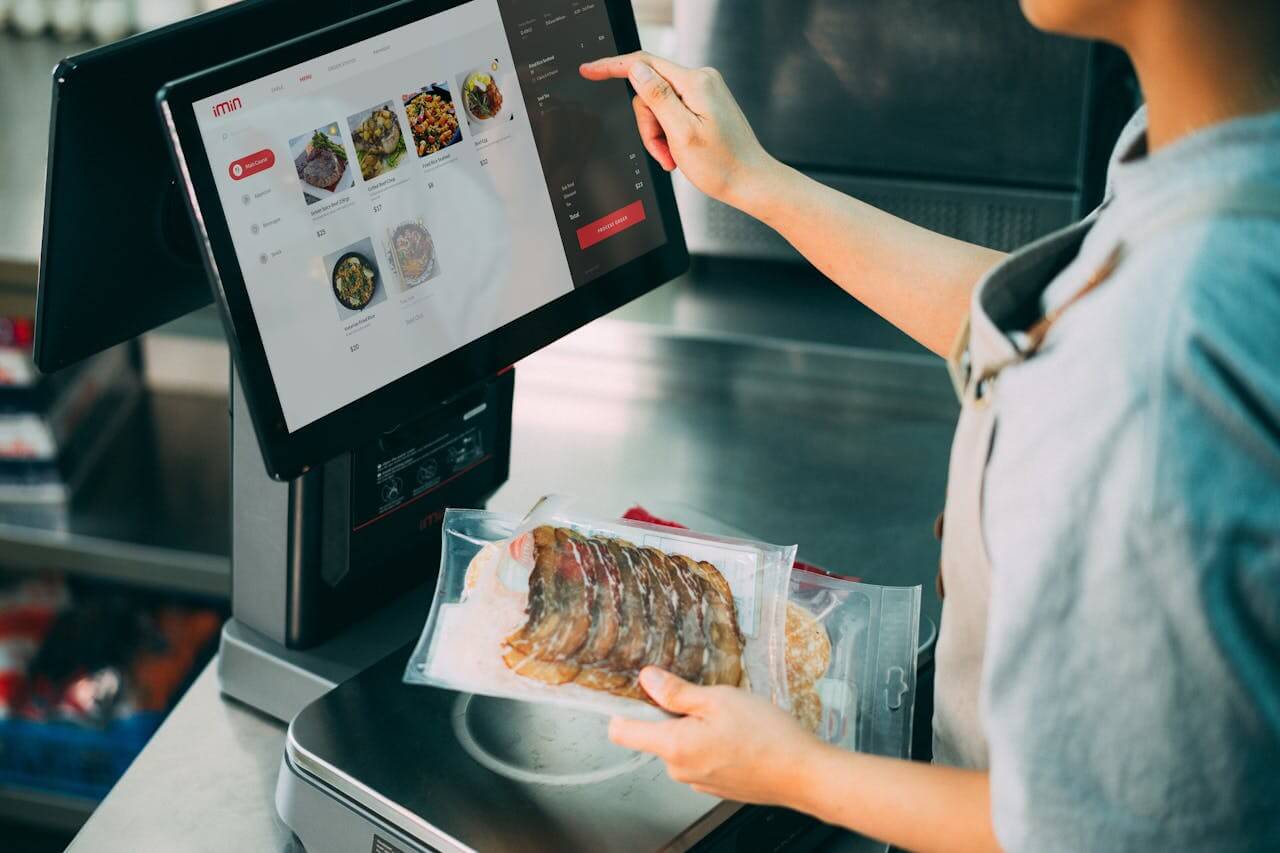
What is POS hardware? POS hardware is the physical components used in a business to process transactions, track stock, and manage sales data. This POS (point of sale) equipment is key to making life easier by streamlining operations, increasing efficiency, and improving the customer experience.
Whether you’re a retail store, restaurant, or any other business, investing in the right POS hardware gives you an edge, simplifies things, and helps to drive growth and profit.
In this post, we’ll cover the basics of POS hardware, including what to consider when choosing, installing, maintaining, and supporting it.
Table of Contents
Typical POS Hardware Components
Here’s a quick reference table of the typical POS equipment needed for a complete system.
While these components are pretty standard, your business type will determine which ones are essential. For example, a restaurant may prioritize a kitchen printer, while a retail store might focus on barcode scanners and scales.
| POS Equipment | Description |
|---|---|
| POS Terminal | The central device where transactions are processed, often a touchscreen monitor. |
| Receipt Printer | Prints receipts for customers; thermal printers are commonly used for efficiency. |
| Cash Drawer | Secure storage for cash transactions, connected to the POS system for auto-opening. |
| Barcode Scanner | Scans product barcodes for fast and accurate item entry during checkout. |
| Card Reader | Processes debit and credit card payments, including contactless and chip cards. |
| Customer Display | Displays transaction details for customers during the checkout process. |
| POS Software | Manages sales, inventory, and reporting; installed on the terminal or cloud-based. |
| Kitchen Printer/KDS | Sends orders to the kitchen; either a traditional printer or a digital Kitchen Display System (KDS). |
| Network Router | Ensures stable internet connectivity for cloud-based POS systems and card readers. |
| Mobile POS Devices | Handheld devices for tableside orders or payments, enhancing mobility and service. |
| Cashless Payment Devices | Supports modern payment methods like digital wallets (e.g., Apple Pay, Google Pay). |
| Label Printer | Prints product labels, barcodes, or pricing tags for inventory management. |
| Scanner Scale | Combines a barcode scanner and scale for weighing and scanning items simultaneously, ideal for grocery stores. |
| Surge Protector/UPS | Protects the POS system from power surges and ensures uptime during outages. |
Understanding the Key Components of POS Hardware
Each piece of POS hardware plays a critical role in ensuring smooth business operations. For a closer look, let’s explore the key components and their functions in detail.
POS Terminals/Registers
POS terminals or registers are the heart of any point-of-sale system. These devices allow you to process transactions, track stock, and collect customer data.
There are many types of POS terminals out there, each with its own features and capabilities, and they include:
- Touch Screen Terminals: These terminals have a modern design with a touch-screen display, making them easy to use and look good. They are for businesses that want a user-friendly interface and a nice setup. They often come with integrated credit card readers and barcode scanners.
- Mobile POS Terminals: As the name suggests, mobile POS terminals are portable devices that can be used anywhere within the business premises. These compact units typically run on iOS or Android operating systems and can be paired with a smartphone or tablet. Mobile POS hardware terminals are perfect for businesses that need flexibility, such as pop-up shops, food trucks, or businesses with multiple service areas.
- Traditional Cash Registers: These are the classic devices many businesses still use due to their simplicity and durability. Traditional cash registers handle essential tasks like calculating totals, providing receipts, and securely storing cash. They are cost-effective and reliable, making them suitable for smaller businesses or those with limited budgets.
Barcode Scanners

Barcode scanners are a key part of any modern POS system; they help simplify things and speed up operations. Their job is to quickly and accurately read barcodes or QR codes on products so you can track stock, prices, and checkout.
The types of barcode scanners are:
Laser Scanners
Laser barcode scanners read barcodes using a laser beam. They are known for their speed and accuracy, making them a popular choice in retail environments. Laser scanners are particularly effective for reading traditional linear (1D) barcodes and can scan from a distance, which is useful for scanning large or heavy items without needing to lift them.
Imaging Scanners
Imaging scanners, also known as camera-based scanners, use a digital camera to capture and decode barcodes. These scanners are versatile and can read both 1D and 2D barcodes, including QR codes.
Imaging scanners are for businesses that use multiple types of barcodes and need a scanner that can handle complex barcode formats. They also perform well in low light and can read damaged or poorly printed barcodes better than laser scanners.
Handheld Scanners
Handheld barcode scanners are portable and easy to use, so they are good for any business environment. They can be laser or imaging scanners and are used by employees to scan items at the point of sale or during stock checks. Handheld scanners come in wired and wireless models, so you have flexibility depending on your business needs.
Fixed-Mount Scanners
Fixed-mount barcode scanners are stationary devices used in high-volume retail environments like supermarkets. These are mounted on checkout counters and allow hands-free scanning, which speeds up the checkout process. They can scan items as they’re passed in front of the scanner, so they are good for businesses with high transaction volumes.
Types of Printers
Receipt printers are part of a POS system for providing customers with a printed copy of their transaction. The types are:
Thermal Printers
Thermal printers are the most common receipt printers in many retail and hospitality environments. They use heat to print on thermal paper so no ink or toner is required.
Pros
- Speed: Thermal printers are fast, so they are good for high-volume environments where speed of transaction is key.
- Quiet Operation: They’re quiet, so they can help create a better customer experience.
- Low Maintenance: Fewer moving parts and no ink or toner means thermal printers are low maintenance.
Cons
- Special Paper Requirement: Thermal printers require thermal paper, which can be more expensive than regular paper.
- Heat Sensitivity: Receipts printed on thermal paper can fade over time, especially when exposed to heat or direct sunlight.
Impact Printers
Impact printers (also known as dot matrix printers) use a series of small pins to strike an inked ribbon to print characters on regular paper. They’re used in environments where duplicate copies of receipts are required, such as restaurant kitchens.
Pros
- Durability: Impact printers are tough and can operate in various environments including high heat or dusty areas.
- Multi-Part Forms: They can print on multi-part forms, so they are good for businesses that need duplicate or triplicate copies of receipts.
- Longevity: The print on impact receipts lasts longer than thermal prints as it’s not affected by heat.
Cons
- Noise: Impact printers are noisier than thermal printers, which can be a problem in quieter environments.
- Slower Speed: They’re generally slower than thermal printers, which may not be suitable for high-traffic areas.
- Higher Maintenance: Impact printers require more maintenance including replacing ink ribbons and more moving parts.
Inkjet Printers
Although not as common as thermal or impact printers, inkjet printers are used for printing high-quality color receipts or logos.
Pros
- High-Quality Print: Inkjet printers can print high-quality color prints, which can enhance receipts with logos and promotional messages.
- Versatility: They can print on various types of paper, including standard paper and labels.
Cons
- Ink Costs: Inkjet printers require regular ink cartridge replacements, which can be expensive over time.
- Maintenance: They need more frequent maintenance, including cleaning and cartridge replacements, compared to thermal printers.
- Speed: Inkjet printers are slower than thermal printers, which can be a problem in busy areas.
Cash Drawers

Cash drawers securely store cash, coins, and other transaction-related items in a business setting. They come in various designs, each tailored to different operational needs and security requirements. The different types of cash drawers include:
Manual Cash Drawers
Manual cash drawers require a key or lever to open, a simple solution with no electronic integration. Used in environments where security and simplicity is key.
These drawers are tough and can be manually opened, so they’re reliable even in the event of a power outage or system failure
Electronic Cash Drawers
Electronic cash drawers are connected to the POS system and open automatically when a cash transaction is processed. They often come with advanced security features like electronic locks, which can be controlled by the POS software. This integration ensures smooth operation and minimizes the risk of theft, as the drawer only opens when authorized by the system.
Flip-Top Cash Drawers
Flip-top cash drawers open from the top, and the lid flips up to reveal the compartments inside. They are used in environments where space is limited, such as mobile setups or small kiosks.
The compact design takes up minimal counter space, and the top opening allows for quick and easy access to cash and coins. It is built with durable materials and a lockable lid to prevent unauthorized access.
USB Cash Drawers
USB cash drawers connect directly to the POS system via a a USB interface. This is a simple and reliable connection method, and setup and integration are easy.
These drawers are controlled by the POS software, which can trigger them to open during transactions. The USB connection ensures fast and secure communication between the drawer and the POS system.
However, POS software compatibility must be checked to ensure integration is seamless.
iPad/Tablet Cash Drawers
iPad/tablet cash drawers are designed for mobile POS setups that use tablets. These drawers connect wirelessly via Bluetooth or through a networked receipt printer.
They offer the flexibility of a modern mobile setup while maintaining the security and functionality of traditional cash drawers. The integration with tablets allows for a seamless checkout process, perfect for businesses looking to use mobile for their POS systems.
Customer-Facing Displays

Customer-facing displays are screens positioned towards the customer at the point of sale, providing transparency and enhancing the shopping experience. These displays show real-time transaction details, items purchased, prices, and totals.
This transparency builds trust and confidence as customers can see what they’ve purchased and the total before they complete the transaction, reducing errors and disputes. By providing instant feedback, these displays help customers to have a smoother checkout and better customer experience.
In addition to transaction details, customer-facing displays can show promotional content and special offers when idle to boost marketing and increase sales.
This dual functionality engages customers with relevant ads and encourages impulse buys and upselling.
Other POS Peripherals
Beyond the core components:
- Scales: For businesses that sell by weight, such as grocery stores, delis, or hardware stores. Modern scales integrate with POS software for accurate and fast weight-based pricing.
- PIN Pads: For businesses that accept debit or credit card payments, customers to enter their PIN or sign for transactions to comply with payment industry regulations and protect sensitive financial data.
- Other Useful Peripherals: Check readers for businesses that accept checks, signature capture devices for electronic signatures, and kitchen printers for restaurants that need to send orders to the kitchen staff.
What to Consider When Choosing POS Hardware
1. Business Type and Size
Different businesses have different hardware needs based on their size and type. For example, retail stores will need robust barcode scanners and customer-facing displays, restaurants will need mobile POS and kitchen printers.
Smaller businesses will opt for simpler, more affordable solutions, while larger businesses will need more advanced, scalable systems to handle higher transaction volumes and more complex operations.
2. Integrated or Stand-alone
Integrated POS systems combine hardware and software into one solution, for seamless operation and ease of use. These are perfect for businesses that want a simple setup with minimal compatibility issues.
Standalone hardware components offer more flexibility and customization but require more work to integrate with existing systems. Businesses should weigh up the pros and cons based on their needs and technical capabilities.
3. Durability and Reliability
Choosing durable and reliable hardware is key to minimizing downtime and keeping operations running. High-quality hardware can withstand heavy use and harsh environments, such as kitchen heat or constant handling in busy retail stores. This reduces the need for frequent replacements and repairs and saves time and money in the long run.
4. Compatibility and Scalability
POS hardware should be compatible with existing software and be able to integrate with other systems. Scalability is also important as businesses need hardware that can grow with them, to handle increased transaction volumes and additional features as needed. Choosing scalable solutions means the POS system will continue to function and be efficient as the business grows.
5. Cost and Budget
Balancing cost with business needs is vital when choosing POS hardware. While it may be tempting to go for the cheapest option, investing in good-quality hardware will save you money in the long run by reducing maintenance costs and increasing reliability.
Businesses should work out their budget and choose hardware that offers the best value for money and meets their operational needs without sacrificing performance.
6. Hardware Installation & Setup
Even the best hardware will fail to deliver if not installed or configured correctly for your business.
When setting up your POS hardware, read the manufacturer’s instructions and guidelines. Proper cable management is important to avoid tangled wires, tripping hazards, and damage to the equipment.
Position your hardware components in a way that promotes workflow and easy access for your staff and customers.
When placing your terminals, displays, and scanners, consider counter space, visibility, and ergonomics. Make sure your hardware is securely mounted or placed on a stable surface to prevent damage or movement during daily use.
If you’re unsure about the installation process or have specific requirements, don’t hesitate to ask for help. Many POS hardware providers offer on-site installation or can recommend certified technicians to make the process smooth and painless.
7. Maintenance & Support
Regular cleaning, software updates, and checking for hardware issues can prevent costly downtime and keep your system running smoothly.
Regarding support, look for a hardware provider that offers reliable and responsive service. A good support team should be able to help you with technical issues, troubleshooting or hardware replacements when needed.
To minimize disruption to your business, consider providers that offer on-site support, remote assistance, or even replacement units.
Also, ask about hardware warranties and service agreements. These will give you peace of mind and protect your investment by covering repairs or replacements within a specific timeframe.
POS Hardware Summary
Choosing the proper POS hardware is crucial for modern businesses to streamline, be efficient, and provide better customer experiences.
From POS terminals and barcode scanners to receipt printers and cash drawers, each component is essential for smooth transactions.
Customer-facing displays increase transparency and trust, while other peripherals like scales and PIN pads cater to specific business needs. Proper installation, regular maintenance, and reliable support are crucial to getting the most out of your POS system.








